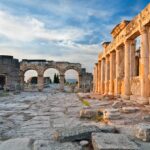Ephesus is one of the largest and most visited ancient cities in Turkey. It is located in an urban district in the south of Izmir, called Selçuk. It is visited by approximately 2 million foreign and local tourists annually. It has many attractions such as the Great Theater of Ephesus (also mentioned in the Bible), the Library of Celsus, the Temple of Hadrian, the Fountain of Trajan, the Monument of Memmius, the Temple of Domitian etc.
According to the Hittite records (the first empire in Asia Minor to rise to prominence in the 2nd millennium B.C.), the city’s first name was Apasas, meaning “the bee.” It was founded as an Ionian city in the 11th century BC. and was moved to its current location in the 3rd century B.C. between the Mount Koressos and the Mount Pion, an area where the Ephesians settled for at least 800 years. It became a Roman city in the 2nd century BC. and during this time it lived its splendor in which it had great political importance for being the largest city in Asia Minor with a population of 250,000 inhabitants, great religious importance due to the presence of the Temple of Artemis, which was one of the seven wonders of ancient world, and much economic importance for having one of the largest ports in the entire Mediterranean world.
According to Christian tradition, Saint John, one of the apostles of Jesus Christ, spent the last years of his life in Ephesus. And since Jesus entrusted her mother to Saint John, it is believed that he brought her here and isolated her on top of Mount Koressos until she ascended to heavens. For this reason, the House of the Virgin Mary is located a few kilometers from Ephesus.
The Great Theater
The Grand Theater of Ephesus is one of the largest in Turkey with a capacity of 25,000 people. It was built in the Hellenistic era in the 2nd century BC, it was enlarged and converted into a Roman theater in the 1st century AD. and got its present form in the 2nd century AD. during the reign of Emperor Trajan.
The theater was severely damaged by earthquakes that occurred in AD 262 and between AD 359-366. After this period, gladiator fights and rough games were held in the theater. The theater was used as a watchtower in the 8th century AD. due to the fact that the wall that ran through the scenic building for defensive purposes lost its original function. Located at the focal point of the city, on the sacred path of Artemis, the theater was the stopping place for religious processions and was also an important gathering and meeting place for the Ephesians. The theater has been a place where silver sculptors rebelled against St. Paul during the period of the spread of Christianity. This uprising is mentioned in the New Testament. In the Bible it is stated that the money changer Demetrius had the Ephesians incite against St. Paul in the theater to collectively sing the motto “Great is the Artemis of Ephesus…”.
The building is still in use today. Many artists like Sting (in 1993) and Elton John (in 2001) gave concerts on this site.
The Library of Celsus
The Celsus Library is the current symbol of the city and the most striking building in Ephesus. It was built in the 2nd century AD. as a mausoleum for Tiberius Julius Celsus Polemaeanus, a Roman consul and a governor of the Province of Asia, whose capital was Ephesus, by his son Gaius Julius Aquila. The governor’s sarcophagus was inside the building.
It is known that it had more than 12,000 scrolls of parchment and papyrus. With this capacity it was one of the largest libraries of antiquity, although the largest was that of Alexandria. The library was destroyed by the attacks of the Goths two centuries after its construction and since it was collapsed on only one occasion, it was rebuilt through very delicate work between the years 1970 and 1978.
In the niches of the building there are four different replica statues whose originals are in a museum in Vienna. Each one symbolizes an admired virtue: Sofia (wisdom), Arete (understanding), Ennoia (reasoning) and Episteme (knowledge).
The Hadrian Temple
Hadrian, who ruled the Roman Empire from 117 to 138, was nicknamed “the traveling emperor” for having visited many cities in his empire. It is known that he visited Ephesus as well and stayed here for three months. And during his stay this striking temple was built.
It is not the size but the decoration that makes the temple one of the most attractive buildings in Ephesus.
In front of the façade, there are four columns that support a triangular front. All that can now be seen of this triangular frontal is the supporting arch, which has the bust of the goddess of fate, Tyche, in the keystone.
On both sides of the door, on the walls, there is a row of friezes representing gods, goddesses, a Dionysian procession and legends. The figures on the left, adjacent to the door, are four female figures holding weapons and shields. They are the Amazons. According to one theory, the Amazons were the first to settle in Ephesus. On the other hand, however, there is another illustration about the founding of the town. Androklos, the legendary founder of the city, chases after the boar who was scared by the fire that the fish started. So both legends about the founding of Ephesus were illustrated on the friezes.
In the interior arch, above the door, there is a relief of a woman. It is believed that she is Medusa. She was always represented with only her head but here we can see her full body. Most likely it was a relief of another woman, but after the work was completed the artist must have gone back and looked at his work. He must have thought: “This beautiful temple… a beautiful work of art needs protection.” So he must have changed the head of that woman, whoever she was, into Medusa to ward off the evil eye.
The Trajan Fountain
The Emperor Trajan had been to all the Roman provinces. Wherever he went, there was a colossal construction built in his name. Some were large and impressive temples, others were grand palaces… but, in this great city of Ephesus, he had preferred to have a building of a modest scale. But with an important message.
The fountain was in the shape of a “U”, two stories high, with a pool in the center. If one can in his imagination replace the cement blocks of the restoration with the marble column that stands next to the fountain, one can get a better idea of its size. Between the columns were the statues of the gods, legendary heroes (Androklos) and members of the royal family. The statue of Emperor Trajan, some three times normal human size, stood in the center. Today only a globular figure and a statue foot of him can be seen.
On a platform of the fountain, stood a colossal statue of the emperor, though all that remains is his right foot and a sphere. The sphere is believed to symbolize the world and the emperor is depicted as the conqueror of the world.
The Memmius Monument
The Memmius Monument is one of the oldest buildings in the city, dating back to the 1st century BC. and it is known that it was dedicated to the grandson of Sulla, a Roman commander/dictator.
“Gaius Memius, the savior, is the son of
Gaius, grandson of Cornelius Sulla”
These lines were inscribed on the monument. Everything mentioned in the inscriptions is illustrated in the reliefs depicting the warriors and their war trophies. Sulla, the Roman dictator, had saved Ephesus from enemy occupation. In memory of his victory, this four-sided arch-shaped victory monument was erected. An inscription shows that this monument was restored by a Roman emperor in the 3rd century AD. C. Despite several restorations and the fact that most of the figured blocks are missing, the original construction can still be easily seen. The base was made of local stone, and the monument itself was made of marble. On each façade there were semicircular niches connected to each other by arches on which were blocks with figures similar to caryatids.
The Domitian Temple
This building was dedicated to a Roman emperor named Domitian (AD 81-91). This Roman emperor was a megalomaniac. He always used the superlative forms of adjectives to describe himself. He would say: “I am the richest, the greatest, the greatest, the most magnificent.” As if these words weren’t enough to describe how big of a deal he was, he would even call his more modest-scale accommodation “the Temple of Domitian,” pretending to be a god.
When the Emperor Domitian granted Ephesus custody of the temple, this temple was built and dedicated to him. To accommodate their megalomania, the Ephesians went to great lengths to give the building a colossal appearance.
The arch-shaped substructure was built to raise the ground level and allow the formation of a 100 by 50 meter terrace. So the temple was built on this terrace and it could be seen from all points of Ephesus. The temple was columned, 13 columns on the sides and 8 in front and in the background. There was an altar in front of the temple. Weapons, soldiers, fight scenes… everything that is still considered a symbol of power… decorated the altar. The huge statue of Domitian had added another impressive image to the entire complex. Only the head and one arm of the statue were found. The arm piece, from knuckles to elbow, measured approximately 180 cm. It is located in the Izmir Archaeological Museum. This measurement suggests that the statue must have been 6-7 meters tall.
The substructure was surrounded by a row of three sets of columns. The columns of the central row were decorated with figures of soldiers. The temple was supposed to be protected.
After the Emperor Domitian was assassinated by one of his servants, the Ephesians no longer cared for him. With an attitude of “The king is dead, long live the new king”, they rededicated the temple in the name of Emperor Vespesian. Later, the temple became a good source of marble for the construction of other buildings.
- Which apostle lived in Ephesus?
According to legend, Saint John spent the last years of his life in Ephesus.
- When was the Celsus Library rebuilt?
The Celsus Library was rebuilt between 1970 and 1978.
- Who is Memmius?
The Memmius Monument was dedicated to the grandson of Sulla, a Roman commander/dictator of the early 1st century BC.




